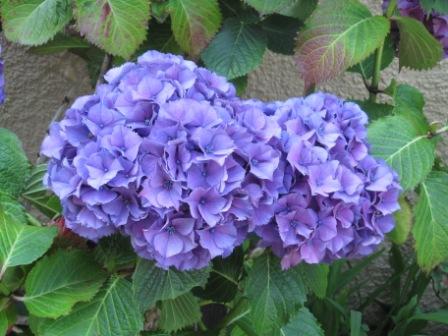Hydrangeas are in full bloom this time of year. I snapped these photos yesterday of several hydrangeas, all planted along the same strip of land. Just look at the different colors:



Why so many colors? Most of you probably know that genetics play a role, as does soil pH. But there’s much more to it than simple soil chemistry and genes.
1. pH: Strongly acidic soils produce blue hydrangeas, while slightly acid to slightly alkaline soils favor pink or red flowers. Soil pH can be modified by adding lime to raise soil pH or ammonium sulfate to acidify the soil.
2. Aluminum: Aluminum, a toxic heavy metal, is required for blue hydrangeas. Like other metallic elements, aluminum binds tightly to clay particles under alkaline conditions. As the pH becomes more acidic, aluminum becomes soluble and can be taken up by plant roots.
3. Nutrients: Relative concentrations of phosphate, nitrogen, and potassium have significant impacts on the uptake and activity of aluminum.
4. Pigments: Blue hydrangea flowers depend on the formation of a complex among three partners: an anthocyanin called delphinidin with a sugar attachment, a phenolic acid co-pigment, and aluminum. Co-pigment differences among species and cultivars will influence flower color.
And here’s an interesting factoid about hydrangeas: ever notice that they are rarely bothered by insects or other animals? Accumulation of a toxin like aluminum in their tissues may be the reason.
How do hydrangeas grow in Florida? You don’t see many in gardens of homeowners. Are they difficult to grow, maintain, etc? Thanks!
Dave, I think some cultivars can grow down there. They need protection from the sun (i.e. east or north facing only) and plenty of water. I’m hoping Ginny Stibolt might jump in with some suggestions here.
In the now-defunct Master Gardener magazine we had an article a few years back on growing hydrangeas east of the Cascades. It’s hot and dry in the summer, cold in the winter. So that information may be somewhat helpful. I’m hoping to get the archived copies of that magazine up on the web in the next month or so. When we do, I’ll let people on the blog know.
“Rarely bothered by other animals”? Around here in central VA hydrangeas are regularly “bothered” (read: chomped to the ground) by deer. After 5 years in the ground, my ‘Annabelle’ never grew any taller than 12″! My only hydrangea success has been oakleaf hydrangea that has somehow grown large enough to survive routine munching to produce a few gorgeous blooms each year.
I’d guess that your soils are probably more alkaline that ours (average is around 5.5). The more alkaline, the less aluminum is taken up. As I recall, ‘Annabelle’ is a white cultivar (and won’t have much aluminum). That may be the difference.
I’ve had customers who purchased Hydrangea macrophylla that was eaten to the ground overnight while awaiting planting, and less frequently ones that were eaten in established gardens. Mopheads are usually
pink in the nursery due to pine bark in the soil mix, and though the clay soils in the mid Atlantic typically are strongly acidic the hydrangeas that were eaten could have been in more neutral soils, or even planted with pine bark soil amendments. I’ll follow up on these reports in the future to check soil pH. I’d love to be able to give some assurance to customers that their hydrangeas won’t end up as dinner.
hydrangeas are not blue when grown in soilless potting mix [no aluminum] and for a year or two after planting in acid soil. Be patient.
Maybe being picky, but I don’t think aluminum is a heavy metal (one with a large atomic weight) but is one of the lightest. There’s probably no correlation between large atomic weight and toxicity.
You’re absolutely right, SJ, it’s not a heavy metal. But it’s often included in lists of toxic heavy metals, and I (perhaps sloppily) include it in that grouping. And I agree that toxicity and atomic number aren’t related.
Dave, I’m not sure what part of Florida you live in, but almost everybody has at least one in their yard in North Florida where I live. I have at least 2 dozen. Email me at annlees@gmail.com if you want some info on growing them.
Yes…gold and silver are both “heavy metals” and I’ve had them in my teeth for years with no ill effects that anyone’s ever told me about. What’s more, the silver is alloyed with one of the “scariest” of the (non-radioactive) heavy metals–mercury. I guess it’s obvious that I’m not an anti-Hg fanatic.
Anyway, the toxicity of chemicals to plants and animals is a fascinating area. Often it’s dose dependent. I seem to recall that some of the unusual conifers native to New Caledonia tolerate if not thrive on the nickel-rich soils there. In institutional landscaping, I’ve often wondered about the possible poisoning of plants as a result of discarded materials from construction or other human activities. It’s impractical to test every square meter of soil, and poisoning could be the explanation for some of those mysterious plant deaths we’ve all witnessed.
I learned that one the hard way. I was visiting my nephew in Oregon. He had this incredibly blue, exactly the color of your pic, hydrangea. So I took a cutting and brought it back to the cntral valley of ca. I’m very casual about cuttings. Just stick them in a pot or the grnd. In the spring it had rooted and I was so excited. The flower bloomed and it was pink! Tried everything and it’s still pnky lavender. Lol what a let down. Lol